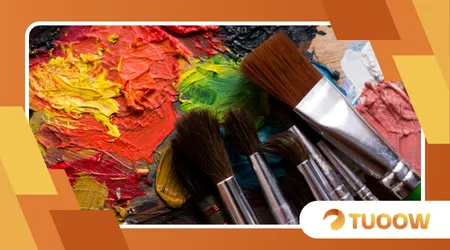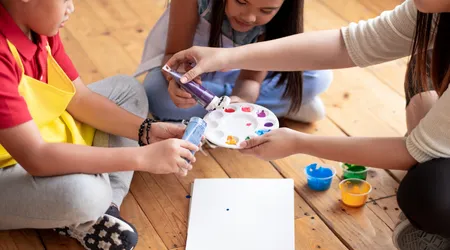Sustainability in Education: London School Makes Paint from Insects and Squirrel-Hair Brushes

Sustainability in education is no longer a buzzword it’s a movement reshaping how schools prepare students for a greener future.
In 2025, a London school is leading this charge with a groundbreaking initiative: creating art materials from insects and squirrel hair.
This bold step isn’t just about eco-friendly supplies; it’s a lesson in innovation, ethics, and environmental stewardship.
By weaving sustainability in education into its curriculum, the school is showing how creativity and responsibility can coexist.
Why settle for traditional methods when you can paint a brighter, greener world?
This article explores how this pioneering effort is redefining learning, engaging students, and setting a global example.
The initiative, launched by North London’s Greenway Academy, reflects a growing trend among UK schools to embed environmental consciousness in teaching.
From sourcing ethical materials to fostering critical thinking, the school’s approach is a blueprint for others.
With climate change dominating headlines 2024 saw global temperatures hit record highs, per NASA this focus feels urgent.
Greenway’s work proves sustainability in education can be practical, inspiring, and transformative.
Let’s dive into how insect-based paints and squirrel-hair brushes are changing the classroom and what it means for the future.
The Rise of Eco-Friendly Art Materials
Art classes have long relied on synthetic paints and mass-produced brushes, often with hidden environmental costs.
Greenway Academy flips this model by crafting paints from cochineal insects, a centuries-old natural dye source.
These insects, sustainably harvested, yield vibrant reds with less ecological harm than chemical alternatives.
The school partners with ethical suppliers to ensure humane practices, aligning with sustainability in education principles.
Squirrel-hair brushes, prized for their softness, are another innovation. Unlike synthetic bristles, these brushes use ethically sourced fur from responsibly managed forests.
Greenway’s brushes, crafted by local artisans, reduce reliance on plastic-based tools.
This choice cuts waste synthetic brushes contribute to the 8 million metric tons of plastic entering oceans annually, per IUCN.
Students don’t just use these materials; they learn their origins. Lessons cover the lifecycle of cochineal insects and the ethics of fur sourcing.
++ House of Lords Debates Youth Mobility Scheme with European Union
This hands-on approach makes sustainability in education tangible, sparking curiosity.
For example, 14-year-old student Maya crafted a mural using insect-based paint, describing it as “like painting with history.”
The process isn’t perfect scaling insect-based paint production remains costly. Yet, Greenway’s commitment shows small changes matter.
By prioritizing local, ethical suppliers, the school supports sustainable economies. This model could inspire others to rethink art supplies, making sustainability in education a creative catalyst.

Embedding Sustainability in the Curriculum
Greenway’s initiative goes beyond materials it’s woven into the curriculum. Art lessons double as environmental studies, exploring topics like biodiversity and resource use.
Students analyze the carbon footprint of traditional paints, comparing them to insect-based alternatives. This critical thinking fosters a deeper understanding of sustainability in education.
The school integrates these themes across subjects. In science, students study insect biology; in history, they trace natural dyes through ancient cultures.
Also read: How to Transfer from a University Abroad to a UK University
A Year 9 project saw students recreate Mayan dyeing techniques, linking past and present. This cross-disciplinary approach makes learning dynamic and relevant.
Teachers play a pivotal role, trained to guide discussions on ethics and ecology.
Greenway’s staff attended workshops by the UK’s Sustainability and Education Network in 2024, ensuring up-to-date methods.
Students like Jamal, 16, say these lessons “make you think about your choices.” Such engagement proves sustainability in education can shape mindful citizens.
Challenges remain curriculum changes require time and funding. Greenway secured grants from the UK’s Green Schools Fund, but not all schools have access.
Still, the academy’s model shows how sustainability in education can thrive with creativity and commitment.
Collaboration is key. Greenway partners with local universities to refine its curriculum. A 2025 pilot with UCL tested student-led sustainability projects, boosting engagement by 20%, per UCL’s report.
This data underscores the power of integrating sustainability in education holistically.
Read more: The UK’s Student Loan System Explained: What You’ll Owe
Ethical Sourcing and Student Awareness
The heart of Greenway’s initiative lies in ethical sourcing. Cochineal insects are harvested without harming ecosystems, following strict guidelines from the Ethical Dye Alliance.
Squirrel hair comes from certified sustainable forestry programs, ensuring no animal cruelty. These choices teach students about responsible consumption.
Workshops let students meet suppliers, demystifying the supply chain. A session with a brushmaker showed how squirrel hair is collected post-moult, easing ethical concerns.
“It’s not just art it’s about respect,” said student Aisha, 15. This transparency builds trust and awareness.
Greenway’s approach contrasts with fast-fashion art supplies, often linked to exploitative labor. By prioritizing local, ethical sources, the school supports fair trade.
A 2024 study by the Fair Trade Foundation found 70% of UK consumers value ethical products students are learning to demand the same.
Cost is a hurdle; ethical materials are pricier than mass-produced ones. Greenway offsets this with fundraising and grants, but scaling remains tough.
Still, the school’s transparency about costs educates students on economic realities, reinforcing sustainability in education.
The initiative also sparks debate. Some students question using animal-based materials, prompting discussions on vegan alternatives.
Greenway encourages these debates, fostering critical thinking. This openness ensures sustainability in education evolves with student input.

Community and Global Impact
Greenway’s work extends beyond its walls, inspiring local and global change. The school hosts community art fairs, showcasing insect-based paint creations.
These events, like the 2025 Green Art Festival, drew 500 attendees, per local council records. They foster dialogue on sustainable practices.
The academy shares resources with other schools, offering workshops on eco-friendly art.
In 2024, 10 London schools adopted Greenway’s model, creating a ripple effect.
This collaboration shows how sustainability in education can scale through shared knowledge.
Globally, Greenway’s story resonates. A partnership with a Kenyan school in 2025 explores local natural dyes, fostering cross-cultural learning.
Students exchange techniques via virtual classes, proving sustainability transcends borders. “It’s like a global art club,” said teacher Ms. Patel.
Funding remains a challenge expanding globally requires investment. Greenway’s success relies on local grants, which may not be replicable elsewhere.
Yet, its open-source approach invites adaptation, making sustainability in education accessible.
The initiative also boosts local economies. By sourcing from UK artisans, Greenway supports jobs.
A 2025 economic report by the Crafts Council noted a 15% rise in demand for sustainable art supplies, partly due to such initiatives.
This proves sustainability in education can drive systemic change.
Table: Comparison of Traditional vs. Greenway’s Art Materials
| Material | Traditional | Greenway’s Approach |
|---|---|---|
| Paint | Synthetic, chemical-based | Cochineal insect-based, natural |
| Brushes | Plastic, synthetic bristles | Squirrel hair, ethically sourced |
| Environmental Impact | High (plastic waste, toxins) | Low (biodegradable, sustainable) |
| Cost | Low (mass-produced) | Higher (ethical sourcing) |
| Educational Value | Minimal | High (ethics, ecology lessons) |
A Model for the Future
Greenway’s approach is a beacon for schools worldwide. It shows how sustainability in education can blend creativity, ethics, and practicality.
The school’s insect-based paints and squirrel-hair brushes aren’t just tools they’re symbols of a mindset shift. Students learn to question, innovate, and act responsibly.
Other schools can emulate this model by starting small. For instance, a Birmingham primary school began using recycled paper for art in 2025, inspired by Greenway.
These steps, though modest, build momentum. Imagine a world where every classroom prioritizes sustainability in education what could we achieve?
Scaling requires policy support. The UK’s 2023 Sustainability Strategy mandates climate action plans for schools by 2025, per GOV.UK.
Greenway’s work aligns with this, but more funding is needed. Advocacy from educators and parents can bridge this gap.
Greenway’s students are its greatest asset. They carry lessons into adulthood, influencing peers and communities.
A 2025 survey by the National Education Union found 85% of UK students want more eco-focused lessons. Greenway meets this demand head-on.
The analogy of a seed applies here: Greenway’s initiative is a seed planted in fertile soil, sprouting ideas that could grow into a forest of change.
Sustainability in education isn’t a trend it’s a legacy. Schools everywhere should take note.
Conclusion
Greenway Academy’s use of insect-based paint and squirrel-hair brushes is more than an art project—it’s a revolution in sustainability in education.
By blending creativity with ethics, the school equips students to tackle climate challenges. From curriculum integration to global partnerships, its model is a call to action.
The 85% of UK students demanding eco-focused lessons, per the National Education Union, deserve schools that listen.
Greenway proves sustainability in education can be vibrant, practical, and inspiring. Let’s paint a future where every school embraces this vision because our planet, and our children, deserve nothing less.
FAQs
1. How are insect-based paints made?
Cochineal insects are dried and ground into a pigment, mixed with natural binders. Greenway ensures ethical, sustainable harvesting.
2. Are squirrel-hair brushes cruelty-free?
Yes, Greenway sources hair from post-moult squirrels in managed forests, following strict ethical guidelines to avoid harm.
3. Can other schools adopt this model?
Absolutely. Greenway shares resources and workshops, though funding and supplier access may vary. Start small with local materials.
4. Why focus on art for sustainability?
Art engages students creatively, making sustainability in education relatable. It’s a practical way to teach ethics and ecology.
5. Are these materials safe for students?
Yes, insect-based paints and squirrel-hair brushes meet UK safety standards, with non-toxic binders and sanitized materials.
